In the field of scrap car recycling and metal regeneration, the scrap car shredder is a core piece of equipment that determines production line efficiency, environmental compliance, and long-term profitability. This article precisely addresses key issues faced by practitioners in equipment procurement, production adaptation, and post-maintenance from three dimensions: "equipment selection pain points → process detail breakdown → operation and maintenance cost control", helping you avoid "low-efficiency pitfalls" in the industry.
I. Core Selection Principles: Avoiding "Performance Pitfalls" of Scrap Car Shredders
1. Shredding Efficiency and Material Adaptability
• For whole-car shredding needs: Prioritize models with a "shredding chamber volume ≥ 5m³" and equipped with a hydraulic forced feeding system. They can directly process un-dismantled whole cars (including non-metallic parts such as seats and glass), eliminating the pre-processing steps of "car compaction and dismantling", and increasing processing efficiency by 50% compared with traditional segmented shredding.
• For hard components (engines/axles): Ensure the cutter material is high-chromium alloy cast steel (Cr12MoV) with the cutting edge treated by "vacuum quenching + deep cryogenic tempering", and the hardness is ≥ HRC60. It can stably shred cast iron parts with HB200-300, avoiding downtime losses caused by cutter "edge chipping".
2. Wear Resistance and Impact Resistance
• The shredding chamber liner must be made of high manganese steel Mn13 (thickness ≥ 80mm). After water toughening treatment, its wear life is 3-5 times longer than ordinary steel. If the annual shredding capacity exceeds 20,000 tons, it is recommended to choose "bimetallic composite liners" to further reduce the replacement cost of wearing parts.
• The main shaft must be a 42CrMo forging and undergo "quenching and tempering + nitriding" treatment (nitriding layer depth 0.4-0.6mm). This ensures that the main shaft has no deformation or cracking risks under high-impact working conditions such as "shredding car frames".
3. Environmental Protection and Safety Compliance
• The dust removal system must meet the requirements of "filtration precision ≤ 1μm for dust and dust removal efficiency ≥ 99%", and be matched with a pulse bag filter and atomizing spray device to ensure that the dust emission in the workshop meets industrial environmental protection standards (avoiding production line shutdown due to environmental supervision).
• The electrical system must pass the IP55 protection level and insulation resistance ≥ 100MΩ test, and the emergency stop function response time is ≤ 1.5 seconds to prevent electric leakage and mis-start risks caused by dusty and humid environments.
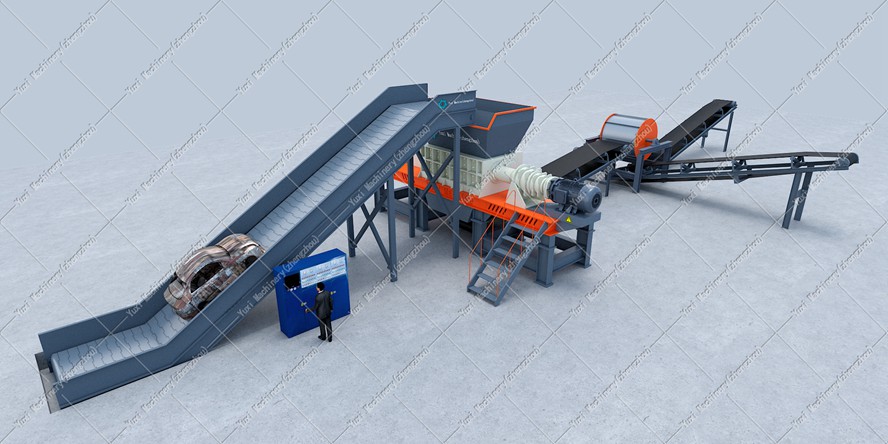
II. Process Details: The "Efficient Production Code" of Scrap Car Shredders
1. Production Process Adaptation (Coordination with Car Shredders)
• Pre-processing stage: Use a car shredder to "roughly shred" the whole car into pieces ≤ 500mm (such as car body shells and doors), and then send them to the shredder for "fine shredding". This can increase the shredder's processing efficiency by 30% and reduce the jamming probability caused by "uneven feeding size" of the shredder.
• Shredding strategies for different materials:
◦ Thin-plate parts (doors/bumpers): Choose "fine-tooth cutters + low rotating speed (15-30r/min)" to avoid excessive dust generated by "over-shredding" of materials.
◦ Thick-wall parts (frames/engines): Switch to "coarse-tooth cutters + high torque (≥ 14,000lbf·ft)" to ensure effective shredding of hard components, and control the discharge particle size to ≤ 50mm (meeting the feeding requirements of downstream recycled metals).
2. Key Installation and Commissioning Points
• The connection between the shredding chamber and the foundation must adopt the "shock pad + secondary grouting" process to reduce vibration transmission during equipment operation (vibration acceleration ≤ 4m/s²) and avoid foundation cracking and equipment displacement caused by long-term vibration.
• No-load commissioning must last for 100 hours, focusing on testing "main shaft dynamic balance, bearing temperature rise (≤ 35℃), and noise (≤ 82dB)". Load commissioning requires continuous shredding of 100 tons of scrap cars to verify the cutter wear rate (≤ 0.5g per ton of processed materials) and shredding chamber tightness.
III. Operation and Maintenance Costs: Practical Methods to Extend Shredder Life by 30%
1. Maintenance of Wearing Parts
• Cutters: After shredding 500 tons of materials, use a micrometer to detect the cutting edge wear. If the wear exceeds 1/3 of the original thickness, timely regrinding is required (regrinding times ≤ 3; otherwise, replace with new cutters). For scenarios involving "shredding multiple types of materials", 2-3 sets of cutters with different tooth shapes can be prepared for quick switching and adaptation.
• Bearings: After 2,000 hours of operation, disassemble and inspect the bearing clearance (replace when the clearance > 0.1mm), and replace the grease at the same time (use molybdenum disulfide high-temperature grease, applicable temperature range: -40℃ to 120℃).
2. Fault Early Warning and Emergency Handling
• Jamming fault: If jamming is caused by "hard foreign objects (such as bolts/nuts)", do not start the equipment forcibly. The foreign objects must be removed by disassembling the shredding chamber. In daily use, a "magnetic separator + metal detector" can be installed at the feed inlet to filter out foreign objects in advance.
• Excessive dust: Check the "bag cleanliness" of the pulse filter and the "nozzle pressure (≥ 0.3MPa)" of the spray device. If the bag is blocked, use compressed air (pressure 0.5-0.7MPa) for reverse purging to restore filtration efficiency.
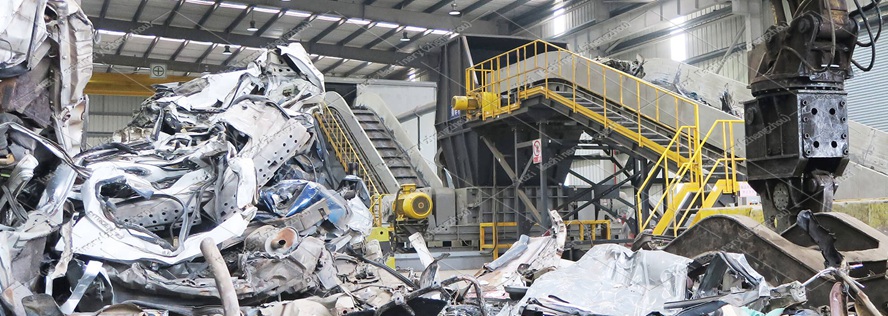
IV. Industry Q&A: Addressing Your Most Concerned "Practical Pain Points"
Q1: For small-scale recycling (annual processing capacity < 10,000 tons), should I choose a used shredder or a new one?
A: Priority should be given to used equipment with "production time ≤ 3 years and complete maintenance records" (on-site verification of "cutter wear rate and main shaft dynamic balance" is required), whose cost is 40% lower than that of new equipment. If the budget allows, for new equipment, it is recommended to choose manufacturers that "support small-batch customization" to avoid electricity waste caused by "excess capacity" of large models.
Q2: The shredder makes too much noise. How to achieve compliance and reduce noise?
A: Solve it from three aspects:
• Equipment end: Ensure normal bearing clearance and gear meshing accuracy reaching AGMA Grade 6 to reduce mechanical noise sources.
• Workshop end: Install "sound-absorbing cotton enclosures + shock-absorbing bases" around the equipment to control the noise at the factory boundary to ≤ 65dB.
• Operation end: Avoid "overload feeding" and keep materials entering the shredding chamber evenly to reduce impact noise.
Q3: The recycled metal materials after shredding have "low purity", which affects the selling price. What should I do?
A: Optimize from two aspects:
• Before feeding: Use the "pre-sorting function" of the car shredder to separate non-metallic parts such as plastics and rubber first.
• After shredding: Install an "eddy current separator + magnetic separator" at the discharge end to separate non-ferrous metals (aluminum/copper) from ferrous metals, improving the purity of recycled materials (e.g., the purity of aluminum can be increased to ≥ 95%, with a premium of up to 300 yuan per ton).
As a core equipment in the field of scrap car recycling and metal regeneration, the selection, process, and operation and maintenance of scrap car shredders need to focus on "efficiency, cost, and compliance". During selection, focus on material adaptability, wear resistance, impact resistance, and environmental safety to avoid the trap of false parameter marking. In production, maximize efficiency and reduce losses through pre-processing with car shredders and targeted shredding strategies for materials. In operation and maintenance, extend equipment life and reduce costs through refined management. Only by taking "matching production capacity, solid technology, and reliable after-sales service" as the standard can practitioners lay a solid foundation for production line profitability and avoid low-efficiency risks in the industry.
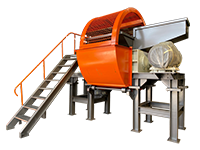 Shredding Machine
Shredding Machine
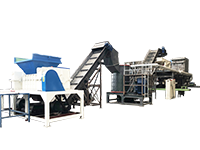 Waste Recycling Line
Waste Recycling Line
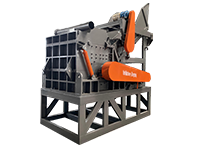 Optional Equipment
Optional Equipment


